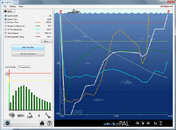I'll have a crack at John's questions too:
1. What depth limits do you have for diving on air?
55m/180ft...
planned and equipped as a technical dive.
I've dove much deeper than that on air before, but I don't think I would do the same again now.
2. I have read over an over again in this thread that it is not for beginners. How much experience does a basic OW diver need to have, and what kind of experience should that be?
A basic OW course doesn't provide any training, knowledge or procedures for deep diving (below 30m). I believe that a specific skill-set and knowledge-base is required for deep diving. Deep air should be treated as a specialised gas - the properties of that gas have changed, compared to shallow water - so it requires specific preparation in the same way that nitrox or trimix would.
3. How does a diver determine how much air is needed for a dive?
Here is what I teach & use:
Scuba Diving Tips - Gas Management WorkshopScuba Tech Philippines
Note: This isn't taught on any mainstream scuba course at recreational level. A diver shouldn't be doing deep dives without the capacity and discipline to go through these steps as a part of dive planning. It's an example of why most recreational divers shouldn't consider deep diving, let alone novice/inexperienced OW trained divers.
4. At what level of remaining gas should a diver begin an ascent?
As dictated by their gas planning. For general recreational dives, a 'rock bottom' is necessary to ensure that the diver can return to the surface whilst air-sharing with their buddy, completing all stops and ascending at a safe rate. For deeper dives, a larger contingency is necessary because there is a danger that an unplanned delay could lead to deco obligation. Rule of Thirds may be deemed appropriate for this.
5. Is there any need for redundancy? Is one tank enough?
For deep diving, potential unplanned delays leading to deco obligation (or greater than expected deco) make redundancy a very prudent option. The diver should be capable of holding their planned deco...and planned contingency (just longer/just deeper) deco regardless of what incidents occur. Without redundancy, this cannot be guaranteed.
6. What protocols do you use for determining a decompression profile?
Laptop software. For routinely visited sites/depths, I have pre-printed and laminate tables for my 'standard' dives and deeper/longer contingencies.
7. What training is needed to be sure one can handle emergencies at depth? (For example, it is very common in technical diving training to find dives losing buoyancy control when first practicing OOA scenarios, so there is training for that. Even when I was working on my full cave certification, the instructor always did the OOA drills in a place with a low ceiling because of the tendency to ascend.)
- Core diving skills should be exemplary and must not diminish when task loading/stress increases.
- Situational awareness should be excellent and must not diminish when task loading/stress increases.
- Precise gas management.
- Precise dive planning and discipline to follow that plan accurately.
- Appropriate procedures/drills specific to deep diving, such as; assisting diver with narcosis, ox-tox rescue, gas depletion, DSMB deployment.
- Stress management techniques.
- Problem solving techniques.
- Equipment specific training, for instance; doubles shut-down drills, long-hose deployment.
A caveat to
all of those is that training itself isn't enough - the diver should be assessed/critiqued to confirm that the standard of their skills is sufficient for the dives to be conducted. It is possible to educate yourself from the internet, or book, and practice with a peer in shallow water - but you still need a mentor or instructor to test your capabilities. It is highly unlikely that a diver can assess their own capabilities effectively - and it is not prudent to expand the demands of your diving
without fully understanding your true capabilities.
8. Is any special equipment needed, or is a standard OW rig just fine? (For example, are DSMBs encouraged, and, if so, is deploying them at depth part of the expected training?)
Personally, I feel that doubles are a must for any dive below 40m.. and many dives below 30m. However, in very generic terms...
- BCD should be capable of securely holding the planned number of cylinders.
- Regulator/s of sufficient performance to cope with deep air demands.
- DSMB and appropriately sized reel, because divers may have to ascend immediately in open water (no time to return to shotline or follow bottom contours).
- Back-up computer or depth/timing devices.
9. Do you have a standard limit for PPO2?#
1.4 PPO2 active / 1.6 PPO2 static




 ), on other arm, I could slowly ascend the wall (?) until time showing is 0, ride the 0 up to the shallow reef, where I incur a couple minutes mandatory (5 minute stop) and then have just enough air for indicated stop (end 300 psi).
), on other arm, I could slowly ascend the wall (?) until time showing is 0, ride the 0 up to the shallow reef, where I incur a couple minutes mandatory (5 minute stop) and then have just enough air for indicated stop (end 300 psi).

